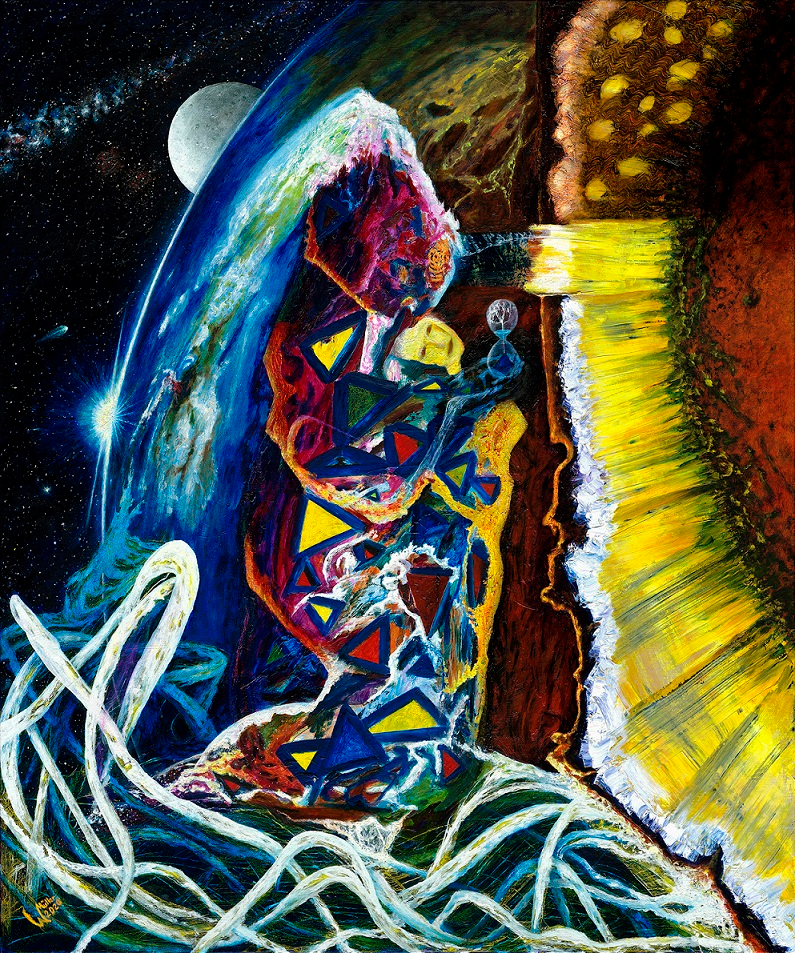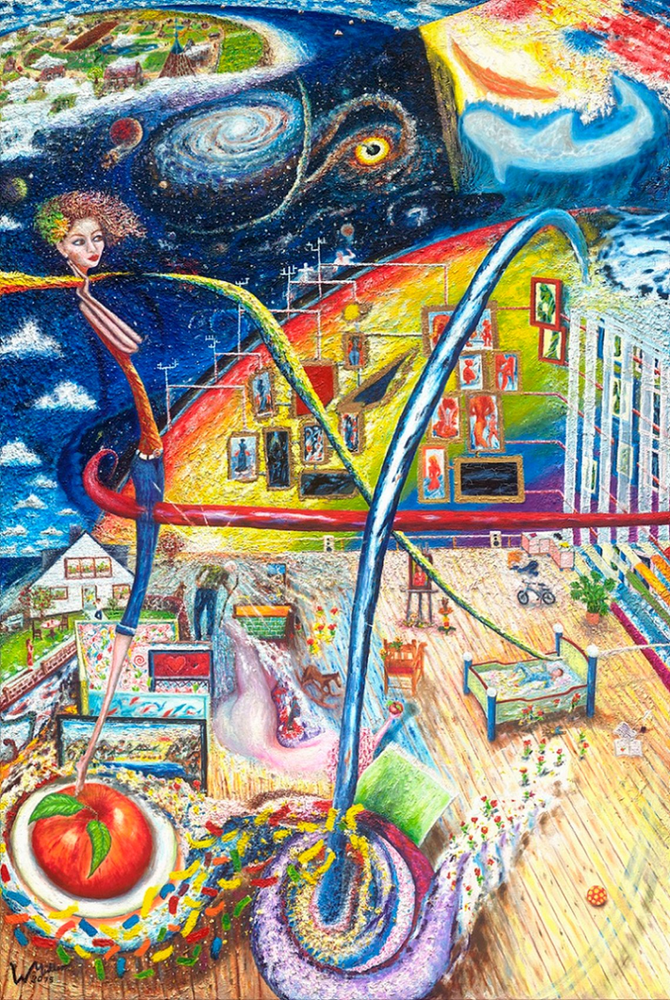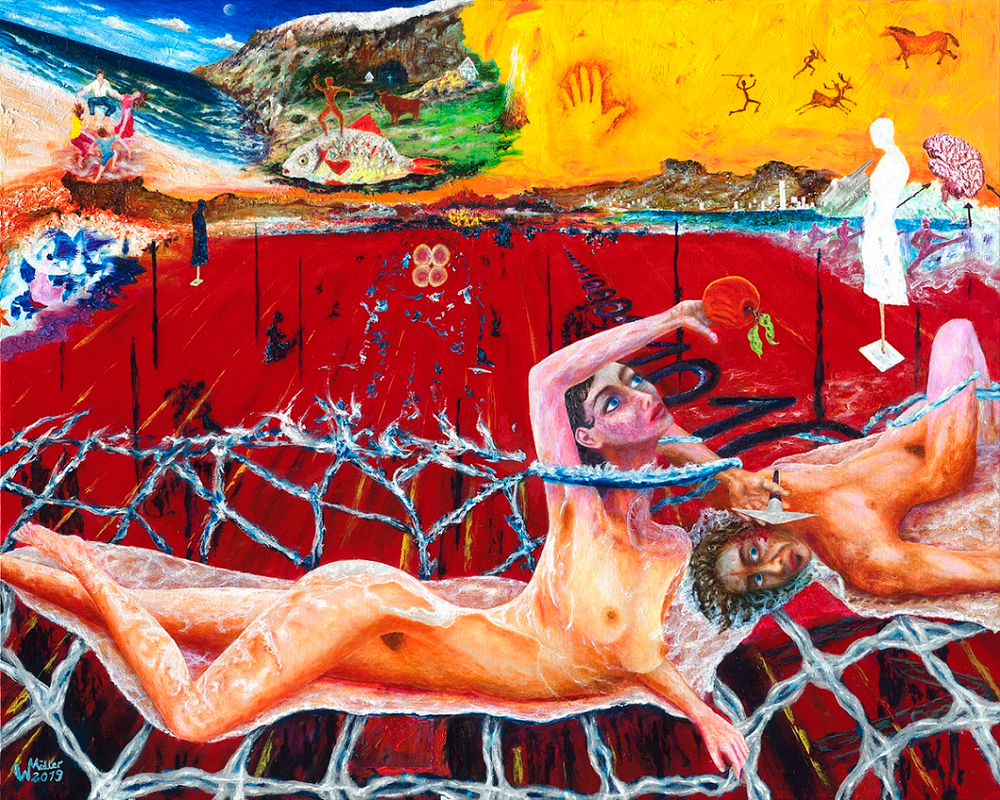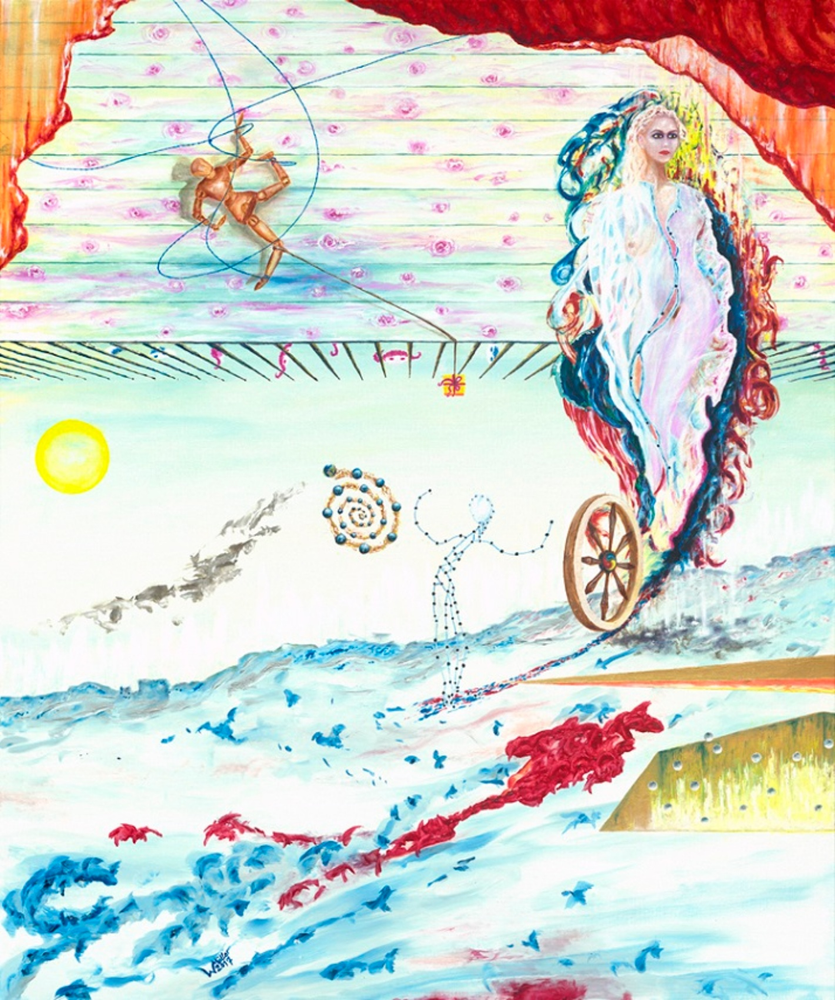
Wolfgang Mueller
L’estro creativo accompagna in modo quasi inconsapevole od ostinatamente persistente l’interiorità di coloro che hanno il dono di sapersi esprimere per immagini, attraverso un’immediatezza che appartiene a chi ha la capacità di filtrare, interpretare, sognare mondi e aspetti della realtà altrimenti inascoltati, trascurati tra le pieghe della quotidianità. Wolfgang Müller scopre presto la sua inclinazione naturale verso la manifestazione pittorica sperimentando la libertà di formarsi in maniera del tutto autonoma, senza avvertire la necessità di lasciare che la dottrina accademica condizionasse in qualche modo il suo stile, la sua tendenza verso una libertà espressiva fondamentale a dar vita a un linguaggio particolare e affascinante. Ama vivere lontano dal rumore della grande città, immerso nella natura e circondato dall’affetto della sua famiglia questo particolare artista tedesco che sa mescolare nelle sue tele la capacità di restare in qualche modo legato a ciò che è reale pur correlandosi al sogno, a mondi immaginari che costituiscono la sua esplorazione verso le infinite possibilità, verso ciò che potrebbe essere se solo la fantasia riuscisse a sopravvivere al pragmatismo della quotidianità. È quasi un’evasione la pittura di Müller, una via per dare un senso a eventi biblici oppure per trovare il significato nascosto dentro azioni e gesti comuni che possono invece coprire qualcosa di più profondo, di maggiormente legato all’essenza dei personaggi narrati o dei luoghi rappresentati. Si colloca decisamente nel Surrealismo la sua arte, laddove però ciò che emerge non è l’inquietudine, l’ansia, le angosce degli incubi che la mente cerca di celare alla ragione bensì ciò che l’artista sottolinea è la bellezza e il piacere di avere un approccio diverso, bizzarro, sognatore, in virtù del quale tutto può divenire più divertente, più aperto a interpretazioni ben lontane da come apparirebbero a una prima occhiata. I colori sono intensi, forti, pieni, e sembrano avvolgere i personaggi o gli oggetti che, come in un racconto fantasy, sembrano prendere vita e descrivere un luogo non luogo dove ogni cosa ha un senso differente da quello ordinario; le forme invece ingannano lo sguardo che sa di essere di fronte a qualcosa di conosciuto ma al tempo stesso si disorienta perché quei riferimenti non sono posti dove ci si aspetterebbe di trovarli bensì sono fuori luogo oppure all’interno di un contesto più ampio, piccoli dettagli di un punto di vista aperto che corrisponde e manifesta l’approccio di Wolfgang Müller nei confronti della realtà ma anche dell’immaginazione. Il sovrapporsi di momenti quotidiani a situazioni fuori contesto contraddistingue l’opera Begrenzte Suche (Ricerca limitata)

Begrenzte Suche
che sembra intrappolare tutti i protagonisti all’interno di un mondo limitato dalla geometricità rettangolare della scena in cui si muovono personaggi decontestualizzati e sproporzionati rispetto a ciò che sta loro accanto, dove una barca sembra sovrastare una casa, dove un’enorme cavalletta sembra giungere per esplorare il mondo umano, dove una scala porta verso il nulla e dove un angelo è in posizione opposta, chissà perché, alla donna che fa giocare il suo bambino. È questo il mondo surreale di Wolgang Müller, un universo fatto di sovrapposizioni, di situazioni illogiche ma al tempo stesso in grado di trasportare l’osservatore in un luogo fantastico dove tutto è diverso e dove tutto può succedere. Andiamo ora a conoscere più a fondo l’artista.
Wolfgang, lei si è formato da autodidatta, ci racconta quali sono stati gli artisti che l’hanno ispirata e che l’hanno indotta a scegliere lo stile surrealista? Quanto ha impiegato per giungere alla forma espressiva che la contraddistingue oggi?
Artisti come Hieronymus Bosch, Jackson Pollock, Otto Dix, Caspar David Friedrich, Vincent van Gogh, solo per citarne alcuni, sono sempre stati quelli che ho amato di più e che sono stati fonte di ispirazione per la mia pittura. Il Surrealismo mi dà la libertà di esprimere i miei sogni, i miei stati d’animo emotivi e altre visioni. È una combinazione di considerazioni filosofiche e politiche con una nuova creazione del linguaggio formale. Mi ci sono voluti molti anni per trovare la mia voce creativa e il viaggio continua ad ogni pennellata. C’è sempre stata in me una ribellione contro le regole commerciali che non apprezzano il Surrealismo, regole stabilite da personaggi potenti che hanno deciso di ignorare istituzionalmente questo stile, tuttavia io proseguo sulla mia strada.

Tellerand
Ha una meravigliosa famiglia e anche un lavoro che condivide con sua moglie, come riesce a trovare il tempo per dipingere? Quali sono le ore della giornata in cui preferisce dedicarsi all’arte?
Sono una persona mentalmente organizzata e anche disciplinata, nel senso che tutto deve avere un suo spazio e una sua collocazione ben precisa, dunque dedico al mio lavoro alcuni orari, alla famiglia altri e alla pittura riservo alcune fasce della giornata, prevalentemente gli orari serali.

Fundament (Fondamento)
Parliamo ora del suo particolare stile pittorico, quanto di ciò che narra nelle sue opere appartiene al mondo dei sogni, suo o dei suoi figli, e quanto invece prende spunto dalla realtà? Qual è il messaggio che desidera lasciare all’osservatore?
Nelle mie opere compaiono disegni visionari, bizzarri e insondabili, oppure paesaggi e strutture che emergono dall’inconscio e sfidano l’interpretazione. Il punto di partenza sono prevalentemente le impressioni ambientali e naturali. Tutto parte dalla definizione mentale del quadro e poi passo alla composizione dopodiché sviluppo pensieri fuori dal processo pittorico, che si manifestano in un prorompente fluire dei sentimenti più intimi sulla tela, mai ripetibili. Le mie immagini vogliono suscitare e sensibilizzare una reazione, una qualsiasi, perché penso che anche questo sia il lavoro di un artista, suscitare emozioni in chi guarda. E a causa dell’ambiguità delle forme vaghe e indefinite, lo spettatore ha spazio per entrare in contatto con la propria anima.

Endlichkeit (Finitezza)
Quanto pensa sia importante nel mondo contemporaneo, lasciarsi una via d’uscita per fuggire dalla realtà e rifugiarsi in un universo fantastico?
L’arte esprime una parte essenziale di ciò che significa essere umani. Attraverso l’arte, i conflitti della vita possono essere messi in luce, esplorati, meglio compresi e condotti verso nuove prospettive. Non posso sfuggire alla realtà, non lo voglio nemmeno, amo la vita. Credo che viviamo in un’epoca di interruzioni senza precedenti nelle relazioni e interazioni umane che influenzano l’intero spettro della vita, dall’individuo al personale, alla geopolitica e all’ambiente. Oggi tendiamo a vedere l’interattività come una tecnologia piuttosto che qualcosa di ormai radicato nelle emozioni e nelle connessioni umane. La mia arte mette direttamente in discussione questo stato di cose per far rivivere e ispirare le dimensioni interpersonali e spirituali della vita umana.

Gefangen (Intrappolata)
Quali sono i suoi prossimi progetti?
Sto meditando da qualche tempo di cominciare a cimentarmi anche nella scultura, forse è questo il progetto più vicino e spero di realizzarlo presto.
WOLGANG MÜLLER-CONTATTI
Email: galerie@mueller-die-galerie.de
Sito web: https://www.wolfgang-mueller-art.de/
Facebook: https://www.facebook.com/profile.php?id=100012975196807
Instagram: https://www.instagram.com/wolfgang.mueller.art/
Marta Lock’s interviews:
Wolfgang Müller, the fascination of improbable realities
Creative inspiration accompanies in an almost unconscious or stubbornly persistent way the interiority of those who have the gift of knowing how to express themselves through images, through an immediacy that belongs to those who have the ability to filter, interpret, dream up worlds and aspects of reality otherwise unheard, overlooked in the folds of everyday life. Wolfgang Müller soon discovered his natural inclination towards pictorial manifestation, experiencing the freedom to form himself in a completely autonomous manner, without feeling the need to let academic doctrine condition his style in any way, his tendency towards a freedom of expression that is fundamental to give life to a particular and fascinating language. This particular German artist likes to live far from the noise of the big city, immersed in nature and surrounded by the affection of his family. In his canvases, he blends the ability to remain in some way linked to what is real while at the same time relating to dreams, to imaginary worlds that constitute his exploration of infinite possibilities, of what could be if only his imagination could survive the pragmatism of everyday life. Müller’s painting is almost an escape, a way of making sense of biblical events or of finding the hidden meaning in common actions and gestures that may instead cover something deeper, something more closely linked to the essence of the characters or places depicted. His art is decidedly Surrealist, but what emerges is not the restlessness, anxiety, the anguish of nightmares that the mind tries to conceal from reason, but what the artist emphasises is the beauty and pleasure of having a different, bizarre, dreamy approach, by virtue of which everything can become more fun, more open to interpretations far removed from how they would appear at first glance. The colours are intense, strong, full, and seem to envelop the characters or objects which, as in a fantasy story, seem to come to life and describe a non-place where everything has a different sense from the ordinary; The shapes, on the other hand, deceive the eye, which knows that it is looking at something familiar but at the same time is disorientated because the references are not where one would expect to find them but are either out of place or within a wider context, small details of an open viewpoint that corresponds to and manifests Wolfgang Müller’s approach to reality but also to the imagination. The superimposition of everyday moments on top of out-of-context situations distinguishes the work Begrenzte Suche (Limited Search), which seems to trap all the protagonists within a world limited by the rectangular geometry of the scene in which decontextualised and disproportionate characters move in relation to their surroundings, where a boat seems to overlook a house, where an enormous grasshopper seems to come to explore the human world, where a staircase leads to nowhere and where an angel is in a position opposite, who knows why, to the woman who is playing with her child. This is Wolgang Müller’s surreal world, a universe made up of superimpositions, of illogical situations, but at the same time capable of transporting the observer to a fantastic place where everything is different and anything can happen. Let us now get to know the artist in greater depth.
Wolfgang, you area self-taught, can you tell us which artists inspired you and led you to choose the surrealist style? How long did it take you to arrive at the form of expression that distinguishes you today?
Artists such as Hieronymus Bosch, Jackson Pollock, Otto Dix, Caspar David Friedrich, Vincent van Gogh, to name but a few, have always been the ones I have loved the most and have been a source of inspiration for my painting. Surrealism gives me the freedom to express my dreams, my emotional moods and other visions. It is a combination of philosophical and political considerations with a new creation of formal language. It took me many years to find my creative voice and the journey continues with every brush stroke. There has always been a rebellion in me against the commercial rules that do not appreciate Surrealism, rules set by powerful people who have decided to institutionally ignore this style, yet I continue on my way.
You have a wonderful family and also a job that you share with your wife, how do you find the time to paint? What times of the day do you prefer to dedicate yourself to art?
I am a mentally organised and disciplined person, in the sense that everything must have its own space and its own precise location, so I dedicate certain hours to my work, others to my family, and I reserve certain parts of the day, mainly in the evenings, for painting.
Now let’s talk about your particular style of painting: how much of what you depict in your artworks belongs to the world of dreams, either yours or your children’s, and how much is inspired by reality? What is the message you wish to leave with the viewer?
In my works there are visionary, bizarre and unfathomable drawings, or landscapes and structures that emerge from the unconscious and challenge interpretation. The starting point is mainly environmental and natural impressions. Everything starts with the mental definition of the picture and then I move on to the composition, after which I develop thoughts outside the painting process, which manifest themselves in a bursting flow of the most intimate feelings on the canvas, which can never be repeated. My images want to provoke and sensitise a reaction, any reaction, because I think that this is also the work of an artist, to provoke emotions in the viewer. And because of the ambiguity of the vague and undefined forms, the viewer has room to get in touch with his own soul.
How important do you think it is in the contemporary world to leave a way out to escape from reality and take refuge in a fantastic universe?
Art expresses an essential part of what it means to be human. Through art, life’s conflicts can be brought to light, explored, better understood and led towards new perspectives. I cannot escape reality, I don’t even want to, I love life. I think we live in an era of unprecedented disruptions in human relationships and interactions that affect the entire spectrum of life, from the individual to the personal, to geopolitics and the environment. Today we tend to see interactivity as a technology rather than something now embedded in human emotions and connections. My art directly challenges this state of affairs to revive and inspire the interpersonal and spiritual dimensions of human life.
What are your next projects?
For some time now, I have been meditating on starting to try my hand at sculpture, perhaps this is the closest project and I hope to realise it soon.
